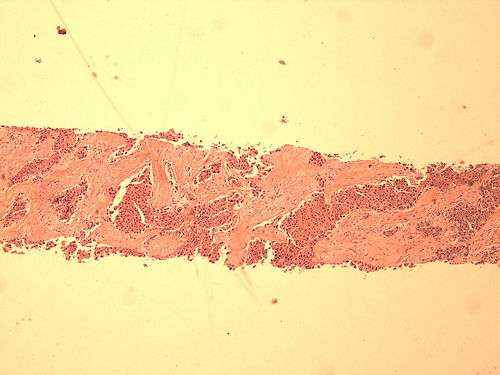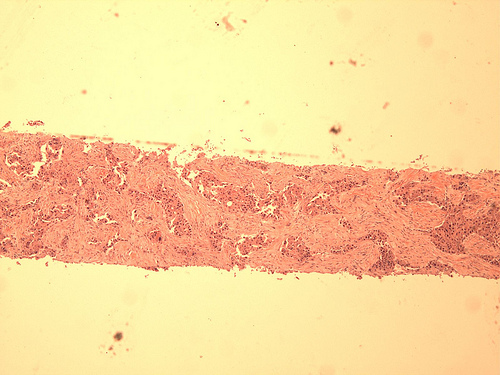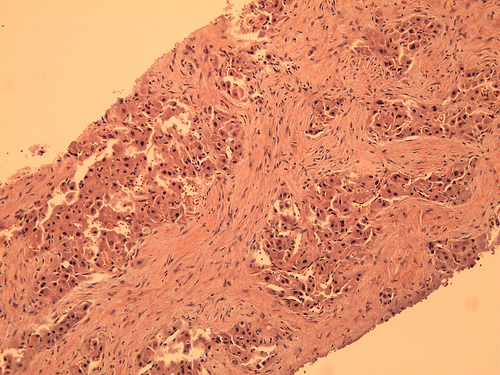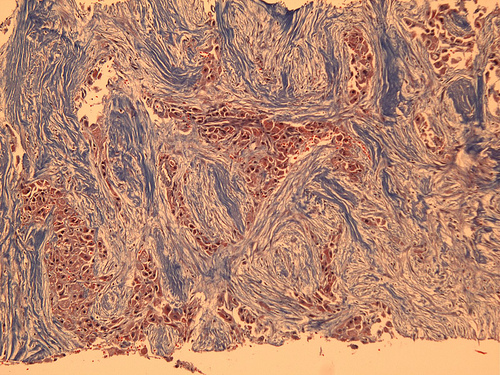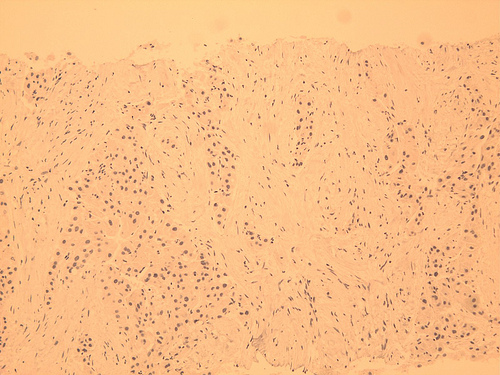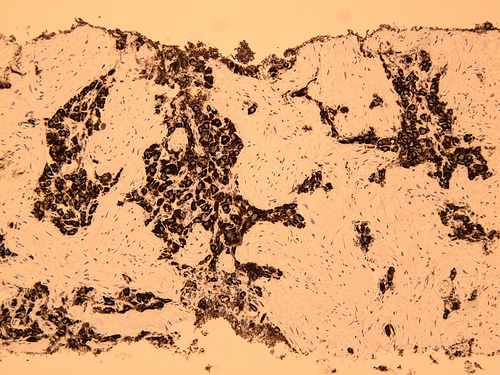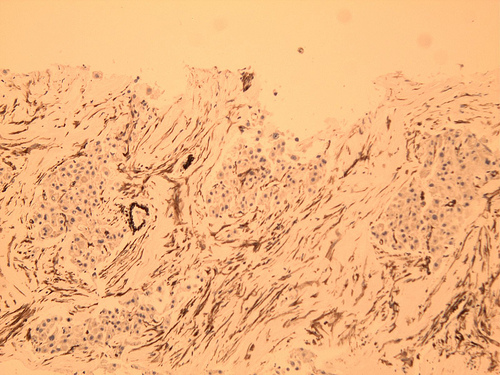6 November 2009 - Case #161
All cases are archived on our website. To view them sorted by case number, diagnosis or category, visit our main Case of the Month page. To subscribe or unsubscribe to Case of the Month or our other email lists, click here.
This case was contributed by Dr. S. Yasir Zaidi, Sinai-Grace Hospital, Wayne State University, Detroit, MI (USA).



This 20-hour workshop is designed to address the activities and issues faced by the surgical pathologist.
The 24th Annual Surgical Pathology Workshop consists of short lectures and case-oriented discussions. Microscopes will be available. Participants will be asked to examine microscopic images and formulate a diagnosis and patient management strategy. The faculty pathologist will then discuss the diagnosis, differential diagnosis, patient management, and other pertinent features. Cases will be selected to represent common and/or difficult diagnostic problems.
This workshop will be held at The Canyons in Park City, Utah. Bring the family and have an incredible winter getaway!
Advertisement
Case #161
Clinical history:
An 18 year old man presented with abdominal pain. CT scans showed a large abdominal mass. A core biopsy was obtained.
Microscopic images:
What is your diagnosis?
Diagnosis: Hepatocellular carcinoma, fibrolamellar variant
Immunostains:
Discussion:
Fibrolamellar hepatocellular carcinoma is uncommon and usually affects young adults aged 20 - 40 years (eMedicine: Fibrolamellar Carcinoma [Accessed 25 April 2024]). It accounts for fewer than 10% of all cases of HCC but 35% of all cases in patients younger than 50 years.
Fibrolamellar carcinoma is typically not associated with underlying liver disease, jaundice or elevated serum levels of alpha fetoprotein. The tumors are typically large at diagnosis (mean 10 - 20 cm), with regional lymph node metastases in 50 - 70%.
Microscopically, fibrolamellar carcinomas have nests, sheets or cords of malignant cells, which are separated by lamellar bands of dense, hypocellular collagen connective tissue. The fibrotic connective tissue coalesces into the central scar. The malignant cells are usually large, well differentiated polygonal cells containing granular cytoplasm, large nuclei and prominent nucleoli (Adv Anat Pathol 2007;14:217). Vascular invasion and necrosis are common and mitotic figures may be present. Fibrolamellar carcinoma is typically immunoreactive for HepPar and CK7 (Am J Clin Pathol 2005;124:512).
The differential diagnosis includes:
Fibrolamellar hepatocellular carcinoma is treated with aggressive surgery (Am J Gastroenterol 2009;104:2617). The 5 year survival is 60 - 75%, better than classic hepatocellular carcinoma (Cancer 2006;106:1331). Early detection of relapse combined with multimodality therapy has been recommended (Eur J Surg Oncol 2009;35:617). These tumors overall show fewer chromosomal abnormalities than classic HCC and tumors with no cytogenetic changes appear to behave less aggressively (Mod Pathol 2009;22:134).
References: Mod Pathol 2005;18:1417, Am J Surg 1986;151:518, Ishak: Tumors of the Liver and Intrahepatic Bile Ducts, 2nd Edition, 2001
All cases are archived on our website. To view them sorted by case number, diagnosis or category, visit our main Case of the Month page. To subscribe or unsubscribe to Case of the Month or our other email lists, click here.
This case was contributed by Dr. S. Yasir Zaidi, Sinai-Grace Hospital, Wayne State University, Detroit, MI (USA).



This 20-hour workshop is designed to address the activities and issues faced by the surgical pathologist.
The 24th Annual Surgical Pathology Workshop consists of short lectures and case-oriented discussions. Microscopes will be available. Participants will be asked to examine microscopic images and formulate a diagnosis and patient management strategy. The faculty pathologist will then discuss the diagnosis, differential diagnosis, patient management, and other pertinent features. Cases will be selected to represent common and/or difficult diagnostic problems.
This workshop will be held at The Canyons in Park City, Utah. Bring the family and have an incredible winter getaway!
Website news:
(1) Based on feedback at the CAP and ASCP conferences, we are planning to update our chapters more frequently with more authors and reviewers. Well keep you advised.
(2) Do you shop at Amazon.com? If so, you can help support PathologyOutlines.com by entering Amazon.com through our Home Page banner or by clicking here. Amazon tags any purchases you make as originating from our website, and pays us a referral fee. It doesn't cost you anything.
Visit and follow our Blog to see recent updates to the website.
(1) Based on feedback at the CAP and ASCP conferences, we are planning to update our chapters more frequently with more authors and reviewers. Well keep you advised.
(2) Do you shop at Amazon.com? If so, you can help support PathologyOutlines.com by entering Amazon.com through our Home Page banner or by clicking here. Amazon tags any purchases you make as originating from our website, and pays us a referral fee. It doesn't cost you anything.
Visit and follow our Blog to see recent updates to the website.
Case #161
Clinical history:
An 18 year old man presented with abdominal pain. CT scans showed a large abdominal mass. A core biopsy was obtained.
Microscopic images:
What is your diagnosis?
Click here for diagnosis and discussion:
Diagnosis: Hepatocellular carcinoma, fibrolamellar variant
Immunostains:
Discussion:
Fibrolamellar hepatocellular carcinoma is uncommon and usually affects young adults aged 20 - 40 years (eMedicine: Fibrolamellar Carcinoma [Accessed 25 April 2024]). It accounts for fewer than 10% of all cases of HCC but 35% of all cases in patients younger than 50 years.
Fibrolamellar carcinoma is typically not associated with underlying liver disease, jaundice or elevated serum levels of alpha fetoprotein. The tumors are typically large at diagnosis (mean 10 - 20 cm), with regional lymph node metastases in 50 - 70%.
Microscopically, fibrolamellar carcinomas have nests, sheets or cords of malignant cells, which are separated by lamellar bands of dense, hypocellular collagen connective tissue. The fibrotic connective tissue coalesces into the central scar. The malignant cells are usually large, well differentiated polygonal cells containing granular cytoplasm, large nuclei and prominent nucleoli (Adv Anat Pathol 2007;14:217). Vascular invasion and necrosis are common and mitotic figures may be present. Fibrolamellar carcinoma is typically immunoreactive for HepPar and CK7 (Am J Clin Pathol 2005;124:512).
The differential diagnosis includes:
- Focal nodular hyperplasia: usually 5 cm or less, fibrous stroma contains bile ductules and inflammatory cells, no hepatocyte atypia
- Hepatocellular carcinoma, sclerosing variant: pseudoglandular pattern common, no oncocytes, smaller tumor cells
- Cholangiocarcinoma
- Adenosquamous carcinoma with sclerosis
- Metastatic carcinoma with sclerotic stroma
- Paraganglioma: may have nesting pattern at biopsy, round nuclei without atypia, vascular stroma but typically no dense fibrosis, positive for neuroendocrine markers (Am J Surg Pathol 2002;26:945)
Fibrolamellar hepatocellular carcinoma is treated with aggressive surgery (Am J Gastroenterol 2009;104:2617). The 5 year survival is 60 - 75%, better than classic hepatocellular carcinoma (Cancer 2006;106:1331). Early detection of relapse combined with multimodality therapy has been recommended (Eur J Surg Oncol 2009;35:617). These tumors overall show fewer chromosomal abnormalities than classic HCC and tumors with no cytogenetic changes appear to behave less aggressively (Mod Pathol 2009;22:134).
References: Mod Pathol 2005;18:1417, Am J Surg 1986;151:518, Ishak: Tumors of the Liver and Intrahepatic Bile Ducts, 2nd Edition, 2001

